The Policy Positioning and Strategic Expectations of Landscape-Scale Green Infrastructure in Japan’s National-Level Policies
Abstract
1. Introduction
- How do these policies define and position LGI? What are the main policy issues and strategic directions?
- How has LGI manifested in terms of temporal trends across these policies?
- What are the thematic preferences of different policy-issuing departments regarding LGI? Are there cross-departmental coordination structures in place?
2. Methodology
2.1. Policy Collection and Compilation
- Policy Effectiveness: Given the broad scope of LGI, which often requires inter-departmental and cross-regional cooperation, policy documents with legal force or formal strategic significance can provide more effective support for the normal development of LGI [41]. Therefore, we selected policy documents issued by national official institutions, including statutory plans, official strategies, and action plans, as the research objects to ensure the authority and effectiveness of the analysis conclusions.
- Policy Coverage Scale: Based on existing LGI practices and research experience, we found that scale is a crucial influencing factor differentiating LGI from other types of GI [42,43]. The judgment standard for “landscape-scale” is not the physical size of the site but the complexity and systematization degree of landscape elements within the site [44,45]. After discussion among all authors and considering Japan’s actual landscape distribution characteristics, we believe that the minimum applicable scale for LGI in Japan is at the prefectural level. Moreover, from a governance perspective, municipal governments, while responsible for implementation, tend to operate with greater autonomy and focus on the management of localized concerns within their own jurisdictions. This top-down planning structure makes the prefectural level more appropriate for examining LGI, which emphasizes inter-regional coordination and systemic spatial integration. Therefore, the policies included in this study’s analysis should have an administrative scope of at least the prefecture level or above.
- Policy Version Time Evolution: Since LGI was officially incorporated into Japanese policy documents, many policies have been updated multiple times. To better grasp the policy orientation, all research objects mentioning LGI will be included in this study’s analysis, regardless of whether subsequent updated versions still involve LGI.
2.2. Text Mining
- Preprocessing and Section Extraction: After retrieval and screening, we collected all policy strategy documents related to LGI issued by various ministries since GI first appeared in Japanese national-level policies. Using Python 3.12.9, the policy texts were cleaned, and based on punctuation marks and chapter titles, the text was divided into sections. We extracted parts containing “グリーンインフラ (GI)”, along with their context, and numbered and recorded basic information about their position in the file.
- Keyword and Topic Identification: Considering that the textual language is Japanese, this study utilized the MeCab tokenizer to parse the corpus, enhancing the accuracy of the conclusions [46]. However, MeCab has certain limitations in processing compound nouns and proper nouns. To mitigate these issues, we conducted manual verification and adjustment of key extracted terms. We first identified high-frequency keywords and distinctive core terms using Term Frequency (TF) and Term Frequency–Inverse Document Frequency (TF–IDF) methods [47,48] and visualized them through word clouds in both Japanese and English. Subsequently, we conducted a co-occurrence analysis to construct a co-occurrence matrix and network, further exploring policy concepts co-occurring with LGI and their structural relationships [49]. Finally, we introduced Latent Dirichlet Allocation (LDA) topic modeling [50,51] to extract potential topics from paragraphs, analyzing the internal thematic structure at the content level and identifying the core topics emphasized by each policy.
- Expression Pattern Clustering Analysis: Since the policy strategies involved in this study come from multiple departments, we used the K-Means Clustering method [38] to identify similarities and differences in expression patterns within policy texts and validate the results of LDA topic identification. This unsupervised clustering analysis categorized paragraphs based on their overall expression style, identifying potential types. By summarizing different policy narrative modes, this provides auxiliary support for the categorization of policy intent and thematic structure.
2.3. Qualitative Comparative Analysis
2.4. Policy Integration Analysis
3. Results
3.1. Distribution and Overview of Policy and Strategy Characteristics
- Policies omitting LGI in subsequent versions: MAFF’s “Basic Plan for Forest and Forestry” mentioned LGI in 2016 but excluded it from the 2021 update. Similarly, MAFF’s “Agriculture, Forestry and Fisheries Research Innovation Strategy 2020” included LGI only in the 2020 strategy; it was absent in the 2021–2024 version.
- Policies lacking updates or experiencing name changes: CAO’s “6th Science, Technology and Innovation Basic Plan” was renamed “Integrated Innovation Strategy” starting in 2021. CS’s “National Resilience Action Plan (2016–2018)” transitioned to “National Resilience Annual Plan” after 2019. “Growth Strategy Follow-up” remained the only policy strategy without subsequent updates.
3.2. Text Mining Results
3.2.1. Keyword Extraction and Co-Occurrence Analysis
3.2.2. LDA Topic Modeling
3.2.3. Expression Style Analysis
3.3. Qualitative Interpretation of Findings
3.3.1. Overview of Policy Content Based on TF and TF–IDF Results
- Disaster Prevention and Emergency Management: LGI is viewed as a crucial tool for addressing various disaster risks and an essential component of building a disaster prevention system.
- Ecological Protection and Natural Resource Management: The introduction of LGI not only aims to protect ecosystems but also emphasizes comprehensive management of natural resources such as forests, rivers, and watersheds. Through NbS, LGI promotes the restoration of ecosystem services while enhancing resource sustainability and environmental resilience.
- Spatial Planning and Regional Governance: LGI is incorporated into the national land use planning system as a key tool for regulating land use and optimizing urban development. It plays a positive role in guiding green development, coordinating urban and rural construction, and promoting regional coordinated development.
- Public–Private Cooperation and Public Management: Policy documents generally emphasize public–private partnership as the core path for advancing LGI implementation, which is also a governance trend for addressing complex social and environmental issues.
- Environmental Transformation and Urban Resilience Orientation: Some policy strategies position LGI as a core driver of environmental transformation and enhancing urban resilience.
- Cross-sectoral Collaboration and Multi-stakeholder Governance: When addressing complex policy issues, some policies emphasize building horizontal coordination mechanisms to promote collaboration across departments, disciplines, and levels, integrating the expertise of government, enterprises, research institutions, and community organizations.
- Institutional and Mechanistic Extension Applications: Some policies explore incorporating LGI concepts into the design of laws, regulations, financial tools, and governance models, demonstrating its high adaptability and institutionalization potential from concept to operation.
- Cultural Embedding and Regional Characteristic Integration: Some policy texts begin exploring the possibility of integrating local culture and regional characteristics into LGI design and implementation, highlighting its social and cultural inclusiveness and adaptability.
3.3.2. Interpretation of Policy Topics Based on LDA
- Topic 1: Institutional Promotion and Policy Implementation
- Topic 2: Land Use and Spatial Integration
- Topic 3: Water Resources and Ecological Regulation
- Topic 4: Disaster Prevention, Mitigation, and Resilience Building
- Topic 5: Ecosystem Protection and Nature Coexistence
- Topic 6: Multi-Stakeholder Participation and Collaborative Governance
- Topic 7: Regional Culture and Social Value Integration
3.3.3. Interpretation of Topic Preferences and Evolution
3.4. Analysis of Policy Integration
4. Discussion
4.1. Evolution of Japan’s LGI Policy Positioning and Institutionalization Challenges in the Global Context
4.2. A Multidimensional Expansion of Japan’s LGI Policy Positioning
4.3. Trends in Topic Evolution and Policy Agenda Shifts
4.4. Pattern Differentiation of Inter-Departmental Coordination Structures
5. Conclusions
Author Contributions
Funding
Data Availability Statement
Conflicts of Interest
Abbreviations
| GI | Green Infrastructure |
| NbS | Nature-based Solutions |
| LGI | Landscape-Scale Green Infrastructure |
| TF | Term Frequency |
| TF–IDF | Term Frequency–Inverse Document Frequency |
| LDA | Latent Dirichlet Allocation |
| MLIT | Ministry of Land, Infrastructure, Transport and Tourism |
| MOE | Ministry of the Environment |
| MAFF | Ministry of Agriculture, Forestry and Fisheries |
| CAO | Cabinet Office |
| CS | Cabinet Secretariat |
| IPCC | Intergovernmental Panel on Climate Change |
| AR5 | IPCC Fifth Assessment Report |
| EU | European Union |
| CBD | Convention on Biological Diversity |
| UNFCCC | United Nations Framework Convention on Climate Change |
| COP28 | 28th Conference of the Parties to the UNFCCC |
| TNFD | Taskforce on Nature-related Financial Disclosures |
| ESG | Expansion of Environmental, Social, and Governance |
| EbA | Ecosystem-based Adaptation |
| PPP | Public–Private Partnerships |
Appendix A
| Issuing Ministry | Date of Publication | Policy Title (in Japanese) |
|---|---|---|
| 国土交通省 MLIT | 2014/3 | 環境行動計画-環境危機を乗り越え、持続可能な社会を目指す- |
| 2014/7 | 国土のグランドデザイン2050 | |
| 2015/8 | 第2次国土形成計画(全国計画) | |
| 2015/8 | 第5次国土利用計画(全国計画) | |
| 2015/9 | 第4次社会資本整備重点計画 | |
| 2015/11 | 国土交通省気候変動適応計画 | |
| 2017/3 | 第4期国土交通省技術基本計画 | |
| 2018/11 | 国土交通省気候変動適応計画 | |
| 2019/7 | グリーンインフラ推進戦略 | |
| 2021/5 | 第5次社会資本整備重点計画 | |
| 2021/7 | グリーン社会の実現に向けた「国土交通グリーンチャレンジ」 | |
| 2021/12 | 国土交通省 環境行動計画 | |
| 2022/4 | 第5期国土交通省技術基本計画 | |
| 2023/7 | 第3次国土形成計画(全国計画) | |
| 2023/7 | 第6次国土利用計画(全国計画) | |
| 2023/9 | グリーンインフラ推進戦略2023 | |
| 2024/6 | 国土交通省防災業務計画 | |
| 環境省 MOE | 2015/11 | 気候変動の影響への適応計画 |
| 2018/4 | 環境基本計画 | |
| 2018/11 | 気候変動適応計画 | |
| 2023/3 | 生物多様性国家戦略 2023–2030 ~ネイチャーポジティブ実現に向けたロードマップ~ | |
| 2024/3 | ネイチャーポジティブ経済移行戦略~自然資本に立脚した企業価値の創造~ | |
| 2024/4 | 環境省防災業務計画 | |
| 2024/8 | 環境研究・環境技術開発の推進戦略 | |
| 2024/8 | 循環型社会形成推進基本計画 ~循環経済を国家戦略に~ | |
| 2025/2 | 地球温暖化対策計画 | |
| 農林水産省 MAFF | 2016/5 | 森林・林業基本計画 |
| 2020/5 | 農林水産研究イノベーション戦略2020について | |
| 2023/3 | 農林水産省生物多様性戦略 | |
| 2023/12 | 国有林野の管理経営に関する基本計画 | |
| 内閣府 CAO | 2021/3 | 第6期科学技術・イノベーション基本計画 |
| 2021/6 | 経済財政運営と改革の基本方針2021について | |
| 2021/6 | 統合イノベーション戦略2021 | |
| 2022/6 | 経済財政運営と改革の基本方針2022について | |
| 2022/6 | 統合イノベーション戦略2022 | |
| 2023/6 | 経済財政運営と改革の基本方針2023について | |
| 2023/6 | 統合イノベーション戦略2023 | |
| 2023/6 | 新しい資本主義の グランドデザイン及び実行計画 2023改訂版 | |
| 2023/6 | PPP/PFI推進アクションプラン (令和5年改定版) | |
| 2024/6 | 経済財政運営と改革の基本方針2024について | |
| 2024/6 | 統合イノベーション戦略2024 | |
| 2024/6 | 新しい資本主義の グランドデザイン及び実行計画 2024改訂版 | |
| 2024/6 | PPP/PFI推進アクションプラン (令和6年改定版) | |
| 内閣官房 CS | 2016/5 | 国土強靱化アクションプラン2016 |
| 2017/6 | 国土強靱化アクションプラン2017 | |
| 2018/6 | 国土強靱化アクションプラン2018 | |
| 2018/12 | 国土強靱化基本計画-強くて、しなやかなニッポンへ- | |
| 2019/6 | 国土強靱化年次計画2019 | |
| 2019/6 | まち・ひと・しごと創生基本方針2019 | |
| 2019/12 | 第2期「まち・ひと・しごと創生総合戦略」 | |
| 2020/6 | 国土強靱化年次計画2020 | |
| 2020/6 | 水循環基本計画 | |
| 2020/7 | まち・ひと・しごと創生基本方針2020 | |
| 2020/12 | 第2期「まち・ひと・しごと創生総合戦略」(2020 改訂版) | |
| 2021/6 | 成長戦略フォローアップ | |
| 2021/6 | 国土強靱化年次計画2021 | |
| 2021/6 | まち・ひと・しごと創生基本方針2021 | |
| 2022/6 | 国土強靱化年次計画2022 | |
| 2022/6 | 水循環基本計画 | |
| 2022/12 | デジタル田園都市国家構想総合戦略 | |
| 2023/7 | 国土強靱化基本計画 | |
| 2023/7 | 国土強靱化年次計画2023 | |
| 2023/12 | デジタル田園都市国家構想総合戦略 (2023 改訂版) | |
| 2024/7 | 国土強靱化年次計画2024 | |
| 2024/8 | 水循環基本計画 | |
| All Ministries | 2021/6 | 2050 年カーボンニュートラルに伴う グリーン成長戦略 |
Appendix B
| Japanese Original Term | English Translation | Frequency | Japanese Original Term | English Translation | Frequency |
|---|---|---|---|---|---|
| 防災 | disaster prevention | 653 | 変動 | fluctuation | 128 |
| 自然 | nature | 389 | 河川 | watercourse | 126 |
| 多様 | diversity | 266 | 文化 | culture | 121 |
| 管理 | management | 264 | 形成 | shaping | 119 |
| 保全 | conservation | 248 | 開発 | development | 118 |
| 減災 | disaster mitigation | 208 | 気候 | climate | 116 |
| 都市 | urban | 182 | 自治 | self-governance | 115 |
| 国土 | territory | 177 | ダム | dam | 114 |
| 地震 | earthquake | 175 | 行う | conduct | 114 |
| 避難 | evacuation | 174 | 通じ | through | 114 |
| 地方 | local | 173 | 適切 | appropriate | 110 |
| 森林 | forest | 172 | 区域 | zone | 110 |
| 耐震 | earthquake resistance | 160 | 実装 | implementation | 109 |
| 土砂 | sediment | 159 | 発揮 | demonstrate | 107 |
| 防止 | prevention | 154 | 訓練 | training | 106 |
| 官民 | public–private | 153 | 想定 | assumption | 105 |
| 公共 | public | 151 | 生態 | ecology | 105 |
| 農水 | agri-water | 150 | プラットフォーム | platform | 105 |
| 維持 | maintenance | 150 | 高い | high | 105 |
| 津波 | tsunami | 144 | コミュニティ | community | 103 |
| 向上 | improvement | 144 | 流域 | watershed | 103 |
| 被害 | damage | 139 | 評価 | evaluation | 103 |
| いく | proceed | 132 | 策定 | formulation | 102 |
| リスク | risk | 129 | 火山 | volcano | 101 |
| 海岸 | coastline | 128 | 持続 | sustainability | 101 |
| Japanese Original Term | English Translation | TF–IDF Value | Japanese Original Term | English Translation | TF–IDF Value |
|---|---|---|---|---|---|
| 自然 | nature | 29.63719939 | 生態 | ecology | 9.006099352 |
| 防災 | disaster prevention | 22.72445976 | 自治 | self-governance | 8.978922796 |
| 官民 | public–private | 22.55209539 | 向上 | improvement | 8.923956132 |
| 多様 | diversity | 22.3168795 | 民間 | private sector | 8.872933416 |
| プラットフォーム | platform | 16.97739978 | 共生 | coexistence | 8.768296085 |
| 都市 | urban | 15.33847627 | 手法 | method | 8.734052432 |
| 実装 | implementation | 13.83718544 | 主体 | actor | 8.592658947 |
| づくり | design | 13.07587259 | 横断 | cross-sectoral | 8.4830987 |
| 持続 | sustainability | 12.65238704 | 維持 | maintenance | 8.294442863 |
| 形成 | shaping | 12.49376182 | 資金 | funding | 8.232139846 |
| 保全 | conservation | 12.36044592 | 目指す | aim | 7.986282136 |
| 管理 | management | 12.32386371 | 拡大 | expansion | 7.79415582 |
| 地方 | local | 11.8167961 | 土地 | land | 7.778884579 |
| 資本 | capital | 11.20613619 | 積極 | proactive | 7.761142671 |
| 国土 | territory | 11.10043952 | 空間 | space | 7.684442315 |
| 分野 | field | 10.99222431 | 考え | thinking | 7.660200995 |
| 減災 | disaster mitigation | 10.64101363 | 実現 | realization | 7.640865867 |
| 緑地 | green space | 10.44360803 | 森林 | forest | 7.407283189 |
| 通じ | through | 10.36204601 | モデル | model | 7.363905883 |
| 公共 | public | 9.48679296 | まちづくり | urban development | 7.346771986 |
| グリーン | green | 9.472256437 | 流域 | watershed | 7.318678172 |
| 開発 | development | 9.46251528 | 戦略 | strategy | 7.305930372 |
| 評価 | evaluation | 9.436303616 | 課題 | challenge | 7.184212177 |
| 魅力 | attractiveness | 9.132181193 | 文化 | culture | 7.170136023 |
| いく | proceed | 9.128326818 | 再生 | regeneration | 7.023673436 |
References
- Zahoor, A.; Xu, T.; Wang, M.; Dawood, M.; Afrane, S.; Li, Y.; Chen, J.L.; Mao, G. Natural and Artificial Green Infrastructure (GI) for Sustainable Resilient Cities: A Scientometric Analysis. Environ. Impact Assess. Rev. 2023, 101, 107139. [Google Scholar] [CrossRef]
- European Commission; Joint Research Centre. Enhancing Resilience of Urban Ecosystems Through Green Infrastructure (EnRoute): Final Report; Publications Office: Luxembourg, 2024. [Google Scholar]
- Khoshnava, S.M.; Rostami, R.; Zin, R.M.; Štreimikiene, D.; Yousefpour, A.; Mardani, A.; Alrasheedi, M. Contribution of Green Infrastructure to the Implementation of Green Economy in the Context of Sustainable Development. Sustain. Dev. 2020, 28, 320–342. [Google Scholar] [CrossRef]
- Artmann, M.; Kohler, M.; Meinel, G.; Gan, J.; Ioja, I.-C. How Smart Growth and Green Infrastructure can Mutually Support Each Other—A Conceptual Framework for Compact and Green Cities. Ecol. Indic. 2019, 96, 10–22. [Google Scholar] [CrossRef]
- Slätmo, E.; Nilsson, K.; Turunen, E. Implementing Green Infrastructure in Spatial Planning in Europe. Land 2019, 8, 62. [Google Scholar] [CrossRef]
- Mell, I.; Clement, S. Progressing Green Infrastructure Planning: Understanding Its Scalar, Temporal, Geo-Spatial and Disciplinary Evolution. Impact Assess. Proj. Apprais. 2020, 38, 449–463. [Google Scholar] [CrossRef]
- Kabisch, N.; Frantzeskaki, N.; Pauleit, S.; Naumann, S.; Davis, M.; Artmann, M.; Haase, D.; Knapp, S.; Korn, H.; Stadler, J.; et al. Nature-Based Solutions to Climate Change Mitigation and Adaptation in Urban Areas: Perspectives on Indicators, Knowledge Gaps, Barriers, and Opportunities for Action. Ecol. Soc. 2016, 21, 39. [Google Scholar] [CrossRef]
- Nesshöver, C.; Assmuth, T.; Irvine, K.N.; Rusch, G.M.; Waylen, K.A.; Delbaere, B.; Haase, D.; Jones-Walters, L.; Keune, H.; Kovacs, E.; et al. The Science, Policy and Practice of Nature-Based Solutions: An Interdisciplinary Perspective. Sci. Total Environ. 2017, 579, 1215–1227. [Google Scholar] [CrossRef]
- Maes, J.; Jacobs, S. Nature-Based Solutions for Europe’s Sustainable Development. Conserv. Lett. 2017, 10, 121–124. [Google Scholar] [CrossRef]
- Zulian, G.; Ronchi, S.; Notte, A.L.; Vallecillo, S.; Maes, J. Adopting a Cross-Scale Approach for the Deployment of a Green Infrastructure. One Ecosyst. 2021, 6, e65578. [Google Scholar] [CrossRef]
- Zhou, L.; Gong, Y.; López-Carr, D.; Huang, C. A Critical Role of the Capital Green Belt in Constraining Urban Sprawl and Its Fragmentation Measurement. Land Use Policy 2024, 141, 107148. [Google Scholar] [CrossRef]
- Sharma, R.; Malaviya, P. Management of Stormwater Pollution Using Green Infrastructure: The Role of Rain Gardens. WIREs Water 2021, 8, e1507. [Google Scholar] [CrossRef]
- Directorate-General for Environment (European Commission). Building A Green Infrastructure for Europe; Publications Office of the European Union: Luxembourg, 2014; ISBN 978-92-79-33428-3. [Google Scholar]
- Benedict, M.; McMahon, E. Green Infrastructure: Smart Conservation for the 21st Century. Renew. Resour. J. 2002, 20, 12–17. [Google Scholar]
- García, A.M.; Santé, I.; Loureiro, X.; Miranda, D. Green Infrastructure Spatial Planning Considering Ecosystem Services Assessment and Trade-Off Analysis. Application at Landscape Scale in Galicia Region (NW Spain). Ecosyst. Serv. 2020, 43, 101115. [Google Scholar] [CrossRef]
- Yang, X.; Wang, Q.; Chen, Y.; Kinoshita, T. Exploration of the Technologies Application Experience of Landscape-Scale Green Infrastructure by the Conservation Fund. Land 2024, 13, 1648. [Google Scholar] [CrossRef]
- Allen, W.L., III. Environmental Reviews and Case Studies: Advancing Green Infrastructure at All Scales: From Landscape to Site. Environ. Pract. 2012, 14, 17–25. [Google Scholar] [CrossRef]
- Basnou, C.; Baró, F.; Langemeyer, J.; Castell, C.; Dalmases, C.; Pino, J. Advancing the Green Infrastructure Approach in the Province of Barcelona: Integrating Biodiversity, Ecosystem Functions and Services into Landscape Planning. Urban For. Urban Green. 2020, 55, 126797. [Google Scholar] [CrossRef]
- Millington, J.D.A. Scale and hierarchy in landscape ecology. In The Routledge Handbook of Landscape Ecology; Routledge: London, UK, 2021; ISBN 978-0-429-39948-0. [Google Scholar]
- Newman, E.A.; Kennedy, M.C.; Falk, D.A.; McKenzie, D. Scaling and Complexity in Landscape Ecology. Front. Ecol. Evol. 2019, 7, 293. [Google Scholar] [CrossRef]
- Leonore, F. When Is a Landscape Perspective Important. In Issues and Perspectives in Landscape Ecology; Cambridge University Press: Cambridge, UK, 2005; pp. 3–10. [Google Scholar]
- Kai, L.I.; Ying, H.O.U.; Skov-Petersen, H.; Andersen, P.S. Research Progress of Green Infrastructure Oriented by Landscape Planning: From the Perspective of “Pattern-Process-Services-Sustainability” Research Paradigm. J. Nat. Resour. 2021, 36, 435–448. [Google Scholar] [CrossRef]
- Arthur, N.; Hack, J. A Multiple Scale, Function, and Type Approach to Determine and Improve Green Infrastructure of urban Watersheds. Urban For. Urban Green. 2022, 68, 127459. [Google Scholar] [CrossRef]
- EU Green Infrastructure Strategy. Available online: https://climate-adapt.eea.europa.eu/en/metadata/publications/eu-green-infrastructure-strategy (accessed on 1 April 2025).
- Hall, P.; Hall, P.; Tewdwr-Jones, M. Urban and Regional Planning, 6th ed.; Routledge: London, UK, 2019; ISBN 978-1-351-26188-3. [Google Scholar]
- Alexander, E.R.; Faludi, A. Planning and Plan Implementation: Notes on Evaluation Criteria. Environ. Plan. B Plan. Des. 1989, 16, 127–140. [Google Scholar] [CrossRef]
- Lyles, W.; Berke, P.; Smith, G. Local Plan Implementation: Assessing Conformance and Influence of Local Plans in the United States. Environ. Plan. B Plan. Des. 2016, 43, 381–400. [Google Scholar] [CrossRef]
- Nakamura, F.; Ishiyama, N.; Yamanaka, S.; Higa, M.; Akasaka, T.; Kobayashi, Y.; Ono, S.; Fuke, N.; Kitazawa, M.; Morimoto, J.; et al. Adaptation to Climate Change and Conservation of Biodiversity Using Green Infrastructure. River Res. Appl. 2020, 36, 921–933. [Google Scholar] [CrossRef]
- Nishihiro, J. Importance of Abandoned Field as Natural Capital: A study based on green infrastructure initiatives in the Inbanuma watershed. J. Rural. Plan. Assoc. 2024, 43, 128–132. [Google Scholar]
- Premchaiswadi, T.; Yaguchi, T. Green infrastructure suitability analysis and its network in tropical city of bangkok for sustainable urban stormwater management. J. Archit. Plan. (Trans. AIJ) 2024, 89, 1087–1098. [Google Scholar] [CrossRef]
- Ito, K. Designing Ecological Network and Green Infrastructure for Onga river, Kyushu, Japan. Kasen 2023, 79, 57–60. [Google Scholar]
- Tabata, S.; Kinoshita, T. A System of Conservation Areas and Green Network Plan of Tokyo as Strategic Planning for Green Infrastructure. Urban Parks = Public Parks 2024, 1, 2–5. [Google Scholar]
- Kim, B.; Matsumoto, H. A study on geographical data that contributes to green infrastructure and green space planning. J. Jpn. Soc. Reveg. Technol. 2023, 49, 141–144. [Google Scholar] [CrossRef]
- Nishida, T.; Toka, H.; Yoshinari, E.; Osawa, T. The impact of local government size on green infrastructure and ecosystem-based disaster prevention/mitigation policy. Jpn. J. Conserv. Ecol. 2024, 2301. [Google Scholar] [CrossRef]
- Otsuka, N.; Abe, H.; Isehara, Y.; Miyagawa, T. The Potential Use of Green Infrastructure in the Regeneration of Brownfield Sites: Three Case Studies from Japan’s Osaka Bay Area. Local Environ. 2021, 26, 1346–1363. [Google Scholar] [CrossRef]
- Katō, S.; Fukuoka, T.; Katagiri, Y. How to Connect Site-scale Projects and City-scale Green Infrastructure Strategies. Rep. City Plan. Inst. Jpn. 2019, 18, 112–116. [Google Scholar] [CrossRef]
- Ueno, Y.; Maeda, Y.; Hasegawa, K.; Minamisaki, S.; Fukushima, A. How to use urban green space as green infrastructure in the era of population decline—From the result of a large scale resident questionnaire in Moriya city, Ibaraki prefecture. J. Jpn. Soc. Civ. Eng. Ser. G (Environ. Res.) 2019, 75, II_169–II_176. [Google Scholar] [CrossRef] [PubMed]
- Massimino, B. Accessing Online Data: Web-Crawling and Information-Scraping Techniques to Automate the Assembly of Research Data. J. Bus. Logist. 2016, 37, 34–42. [Google Scholar] [CrossRef]
- Kocerka, J.; Krześlak, M.; Gałuszka, A. Analysing Quality of Textual Requirements Using Natural Language Processing: A Literature Review. In Proceedings of the 2018 23rd International Conference on Methods & Models in Automation & Robotics (MMAR), Międzyzdroje, Poland, 27–30 August 2018; pp. 876–880. [Google Scholar]
- Mitchell, R. Web Scraping with Python: Collecting More Data from the Modern Web; O’Reilly Media, Inc.: Sebastopol, CA, USA, 2018; ISBN 978-1-4919-8552-6. [Google Scholar]
- Lascoumes, P.; Le Gales, P. Introduction: Understanding Public Policy through Its Instruments—From the Nature of Instruments to the Sociology of Public Policy Instrumentation. Governance 2007, 20, 1–21. [Google Scholar] [CrossRef]
- Hung, F.; Harman, C.J.; Hobbs, B.F.; Sivapalan, M. Assessment of Climate, Sizing, and Location Controls on Green Infrastructure Efficacy: A Timescale Framework. Water Resour. Res. 2020, 56, e2019WR026141. [Google Scholar] [CrossRef]
- Ahern, J. Green Infrastructure for Cities: The Spatial Dimension. In Cities of the Future: Towards Integrated Sustainable Water and Landscape Management; IWA Publishing: London, UK, 2007; Volume 13, pp. 267–283. [Google Scholar]
- Band, L.E.; Moore, I.D. Scale: Landscape Attributes and Geographical Information Systems. Hydrol. Process. 1995, 9, 401–422. [Google Scholar] [CrossRef]
- Bastian, O.; Krönert, R.; Lipský, Z. Landscape Diagnosis on Different Space and Time Scales—A Challenge for Landscape Planning. Landsc. Ecol. 2006, 21, 359–374. [Google Scholar] [CrossRef]
- Yamamoto, K.; Miyanishi, Y.; Takahashi, K.; Inomata, Y.; Mikami, Y.; Sudo, Y. What We Need Is Word, Not Morpheme; Constructing Word Analyzer for Japanese. In Proceedings of the 2015 International Conference on Asian Language Processing (IALP), Suzhou, China, 24–25 October 2015; pp. 49–52. [Google Scholar]
- Zhang, W.; Yoshida, T.; Tang, X. A Comparative Study of TF*IDF, LSI and Multi-Words for Text Classification. Expert Syst. Appl. 2011, 38, 2758–2765. [Google Scholar] [CrossRef]
- Qaiser, S.; Ali, R. Text Mining: Use of TF-IDF to Examine the Relevance of Words to Documents. Int. J. Comput. Appl. 2018, 181, 25–29. [Google Scholar] [CrossRef]
- Radhakrishnan, S.; Erbis, S.; Isaacs, J.A.; Kamarthi, S. Novel keyword co-occurrence network-based methods to foster systematic reviews of scientific literature. PLoS ONE 2017, 12, e0172778. [Google Scholar] [CrossRef]
- Jelodar, H.; Wang, Y.; Yuan, C.; Feng, X.; Jiang, X.; Li, Y.; Zhao, L. Latent Dirichlet Allocation (LDA) and Topic Modeling: Models, Applications, a Survey. Multimed. Tools Appl. 2019, 78, 15169–15211. [Google Scholar] [CrossRef]
- Blei, D.M.; Ng, A.Y.; Jordan, M.I. Latent Dirichlet Allocation. J. Mach. Learn. Res. 2003, 3, 993–1022. [Google Scholar]
- Greckhamer, T.; Furnari, S.; Fiss, P.C.; Aguilera, R.V. Studying Configurations with Qualitative Comparative Analysis: Best Practices in Strategy and Organization Research. Strateg. Organ. 2018, 16, 482–495. [Google Scholar] [CrossRef]
- Supervised and Unsupervised Machine Learning Techniques for Text Document Categorization. Available online: https://www.researchgate.net/publication/277284849_Supervised_and_Unsupervised_Machine_Learning_Techniques_for_Text_Document_Categorization (accessed on 1 April 2025).
- Tosun, J.; Lang, A. Policy integration: Mapping the different concepts. Policy Stud. 2017, 38, 553–570. [Google Scholar] [CrossRef]
- Runhaar, H.; Driessen, P.; Uittenbroek, C. Towards a Systematic Framework for the Analysis of Environmental Policy Integration. Environ. Policy Gov. 2014, 24, 233–246. [Google Scholar] [CrossRef]
- Nilsson, M.; Persson, A. Framework for Analysing Environmental Policy Integration. J. Environ. Policy Plan. 2003, 5, 333–359. [Google Scholar] [CrossRef]
- Jin, Z.; Wei, Y. UMPA: Unified Multi-Modal Prompt with Adapter for Vision-Language Models. Multimed. Syst. 2025, 31, 125. [Google Scholar] [CrossRef]
- IPCC. Climate Change 2014 Synthesis Report; IPCC: Geneva, Szwitzerland, 2014; pp. 1059–1072. [Google Scholar]
- Munang, R.; Andrews, J.; Alverson, K.; Mebratu, D. Harnessing Ecosystem-based Adaptation To Address the Social Dimensions of Climate Change. Environ. Sci. Policy Sustain. Dev. 2014, 56, 18–24. [Google Scholar] [CrossRef]
- Doswald, N.; Munroe, R.; Roe, D.; Giuliani, A.; Castelli, I.; Stephens, J.; Möller, I.; Spencer, T.; Vira, B.; Reid, H. Effectiveness of Ecosystem-Based Approaches for Adaptation: Review of the Evidence-Base. Clim. Dev. 2014, 6, 185–201. [Google Scholar] [CrossRef]
- Chong, J. Ecosystem-Based Approaches to Climate Change Adaptation: Progress and Challenges. Int. Environ. Agreem. Polit. Law Econ. 2014, 14, 391–405. [Google Scholar] [CrossRef]
- Munang, R.; Thiaw, I.; Alverson, K.; Mumba, M.; Liu, J.; Rivington, M. Climate Change and Ecosystem-Based Adaptation: A New Pragmatic Approach to Buffering Climate Change Impacts. Curr. Opin. Environ. Sustain. 2013, 5, 67–71. [Google Scholar] [CrossRef]
- 環境:【導入編】なぜ、今グリーンインフラなのか—国土交通省. Available online: https://www.mlit.go.jp/sogoseisaku/environment/sosei_environment_fr_000143.html (accessed on 16 May 2025).
- 環境:第1回 グリーンインフラ懇談会 配付資料—国土交通省. Available online: https://www.mlit.go.jp/sogoseisaku/environment/sosei_environment_tk_000018.html (accessed on 16 May 2025).
- Galanakis, C.M.; Brunori, G.; Chiaramonti, D.; Matthews, R.; Panoutsou, C.; Fritsche, U.R. Bioeconomy and green recovery in a post-COVID-19 era. Sci. Total Environ. 2022, 808, 152180. [Google Scholar] [CrossRef] [PubMed]
- Boyle, A.D.; Leggat, G.; Morikawa, L.; Pappas, Y.; Stephens, J.C. Green New Deal proposals: Comparing emerging transformational climate policies at multiple scales. Energy Res. Soc. Sci. 2021, 81, 102259. [Google Scholar] [CrossRef]
- Kedward, K.; Ryan-Collins, J. A Green New Deal: Opportunities and Constraints. In Economic Policies for Sustainability and Resilience; Arestis, P., Sawyer, M., Eds.; Springer International Publishing: Cham, Switzerland, 2022; pp. 269–317. ISBN 978-3-030-84288-8. [Google Scholar]
- Galvin, R.; Healy, N. The Green New Deal in the United States: What It Is and How to Pay for It. Energy Res. Soc. Sci. 2020, 67, 101529. [Google Scholar] [CrossRef]
- Smol, M. Is the Green Deal a Global Strategy? Revision of the Green Deal Definitions, Strategies and Importance in Post-COVID Recovery Plans in Various Regions of the world. Energy Policy 2022, 169, 113152. [Google Scholar] [CrossRef]
- Pettorelli, N.; Graham, N.A.J.; Seddon, N.; Maria da Cunha Bustamante, M.; Lowton, M.J.; Sutherland, W.J.; Koldewey, H.J.; Prentice, H.C.; Barlow, J. Time to Integrate Global Climate Change and Biodiversity Science-Policy Agendas. J. Appl. Ecol. 2021, 58, 2384–2393. [Google Scholar] [CrossRef]
- Unit, B. COP Decisions. Available online: https://www.cbd.int/health/decisions.shtml (accessed on 1 April 2025).
- Asif, Z.; Chen, Z.; Sadiq, R.; Zhu, Y. Climate Change Impacts on Water Resources and Sustainable Water Management Strategies in North America. Water Resour. Manag. 2023, 37, 2771–2786. [Google Scholar] [CrossRef]
- UN Climate Change Conference—United Arab Emirates|UNFCCC. Available online: https://unfccc.int/cop28 (accessed on 1 April 2025).
- Green, D.; O’Donnell, E.; Johnson, M.; Slater, L.; Thorne, C.; Zheng, S.; Stirling, R.; Chan, F.K.S.; Li, L.; Boothroyd, R.J. Green Infrastructure: The Future of Urban Flood Risk Management? WIREs Water 2021, 8, e1560. [Google Scholar] [CrossRef]
- Oral, H.V.; Carvalho, P.; Gajewska, M.; Ursino, N.; Masi, F.; van Hullebusch, E.D.; Kazak, J.K.; Exposito, A.; Cipolletta, G.; Andersen, T.R.; et al. A Review of Nature-Based Solutions for Urban Water Management in European Circular Cities: A Critical Assessment Based on Case Studies and Literature. Blue-Green Syst. 2020, 2, 112–136. [Google Scholar] [CrossRef]
- Vardon, M.; Lucas, P.; Bass, S.; Agarwala, M.; Bassi, A.M.; Coyle, D.; Dvarskas, A.; Farrell, C.A.; Greenfield, O.; King, S.; et al. From COVID-19 to Green Recovery with Natural Capital Accounting. Ambio 2023, 52, 15–29. [Google Scholar] [CrossRef]
- Lee, E.; Kim, G. Analysis of Domestic and International Green Infrastructure Research Trends from the ESG Perspective in South Korea. Int. J. Environ. Res. Public. Health 2022, 19, 7099. [Google Scholar] [CrossRef]
- Council/Committee, etc.: 1st Joint Meeting of the Green Society Subcommittee, Environmental Committee of the Council for Social Infrastructure Development, and Environmental Committee of the Transport System Subcommittee, Transport Policy Council—Ministry of Land, Infrastructure, Transport and Tourism (MLIT). Available online: https://www.mlit.go.jp/policy/shingikai/sogo10_sg_000201.html (accessed on 16 May 2025).


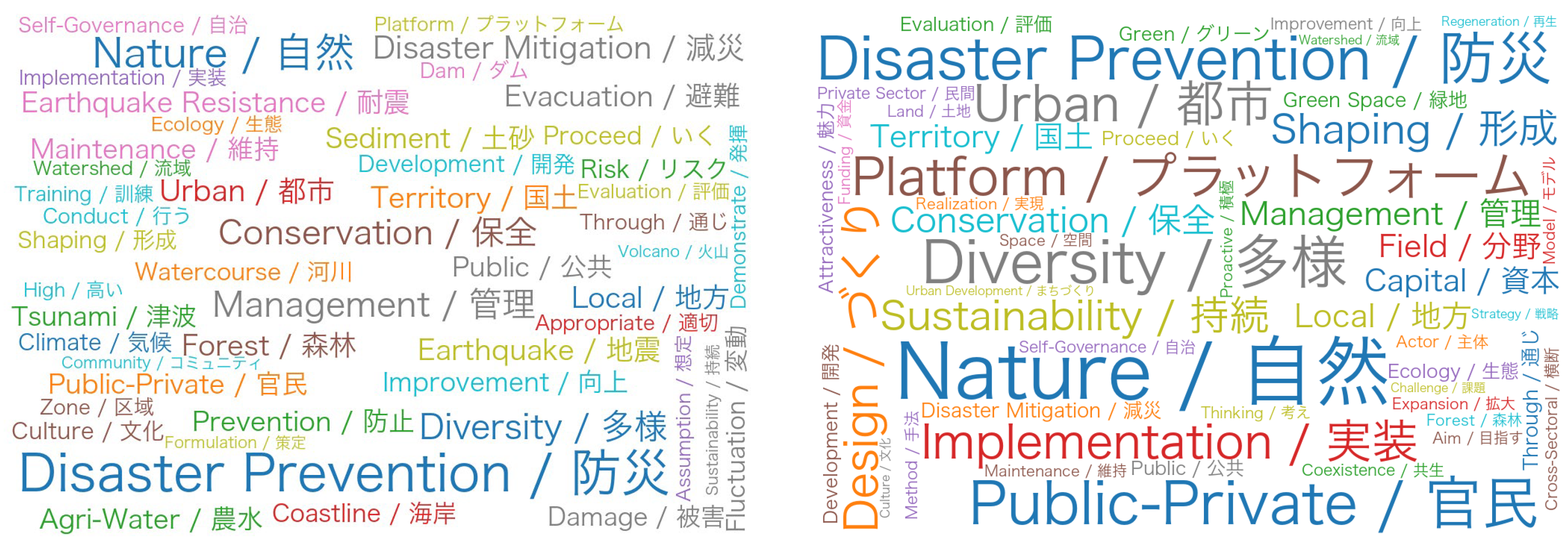

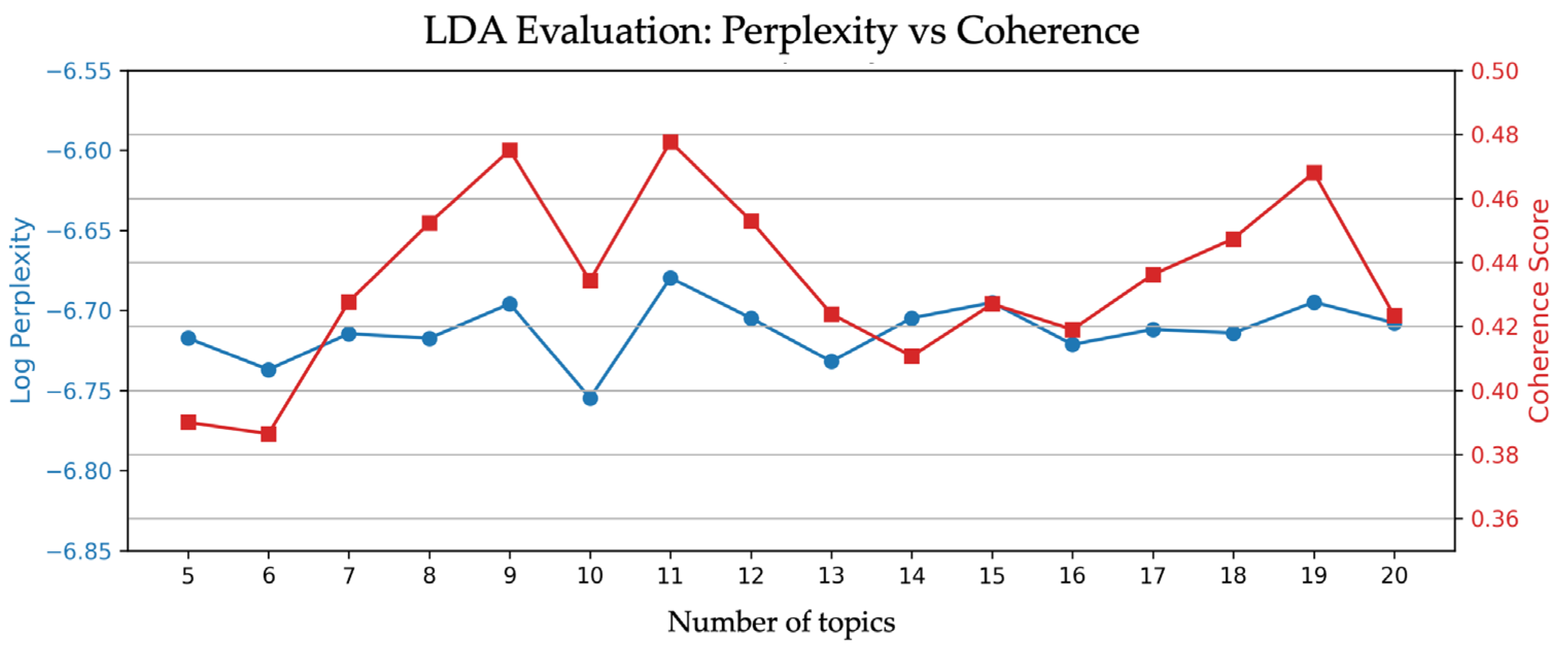


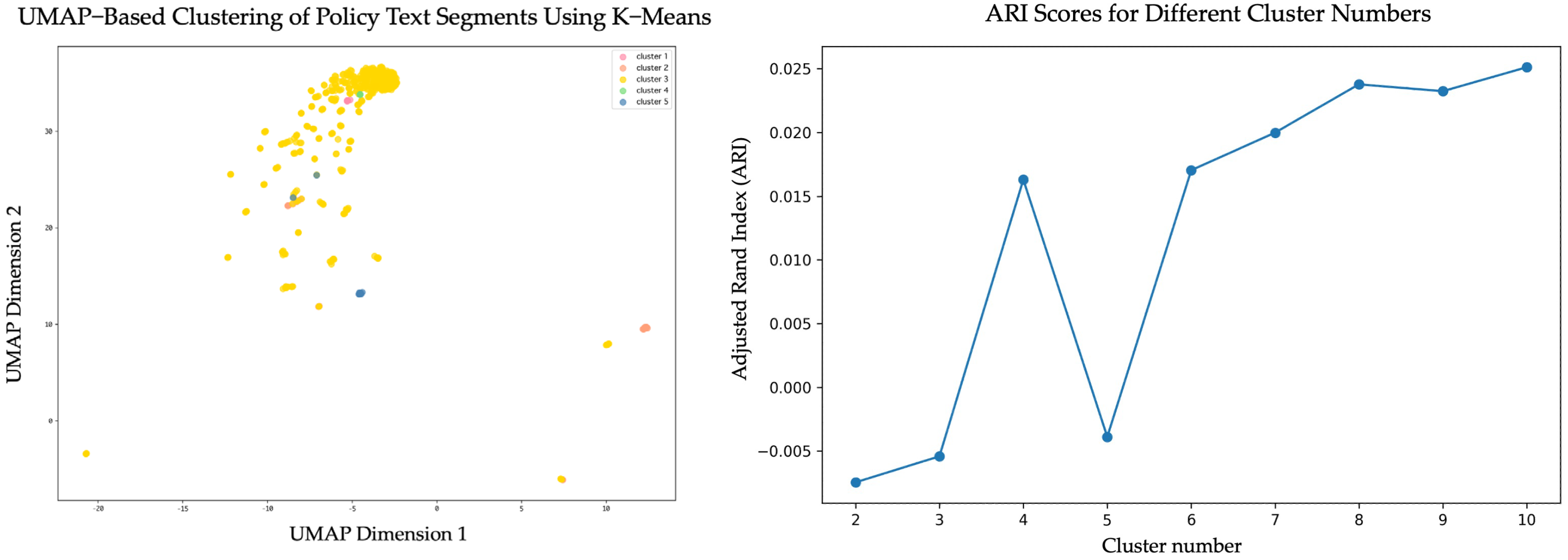
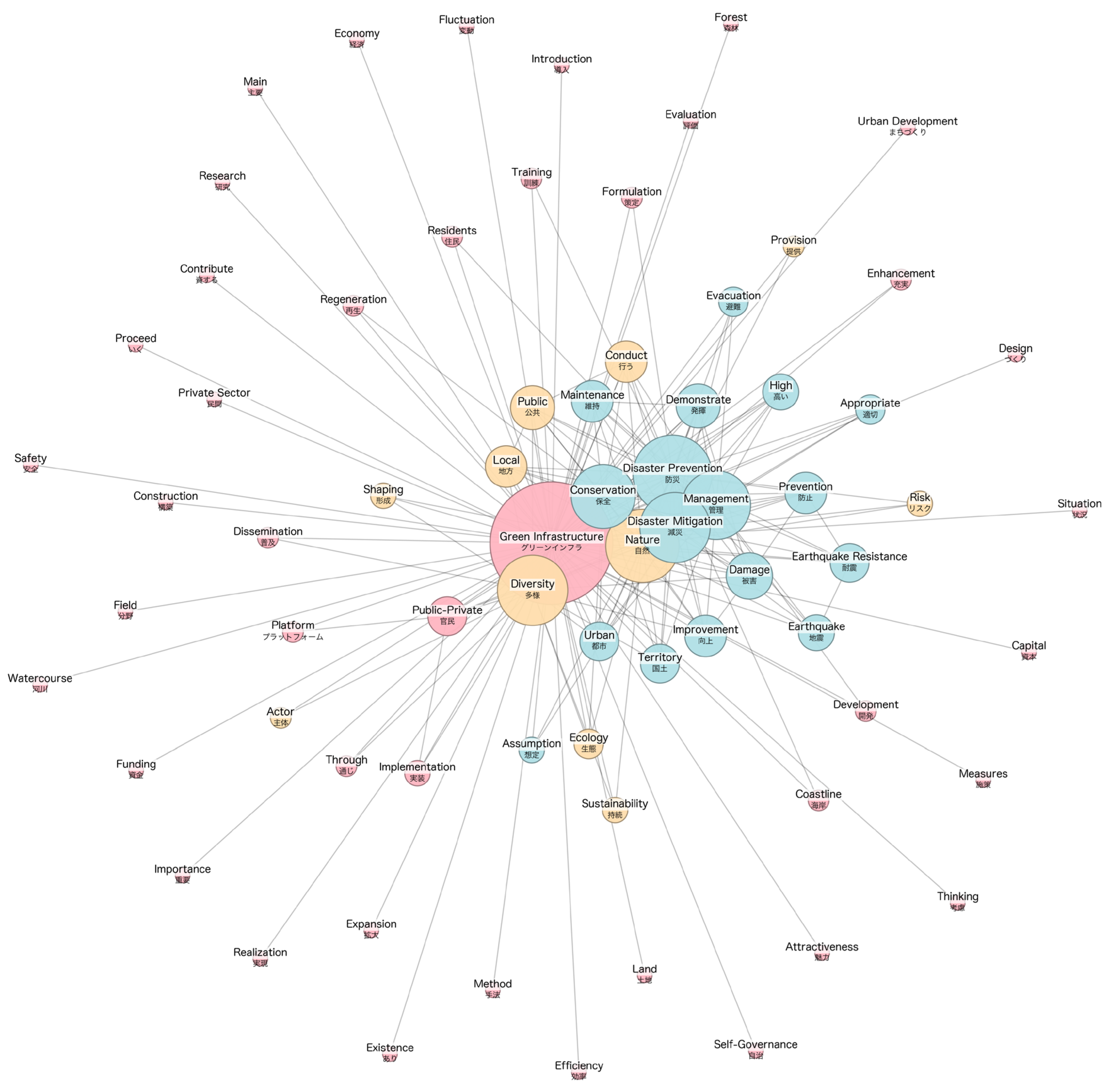
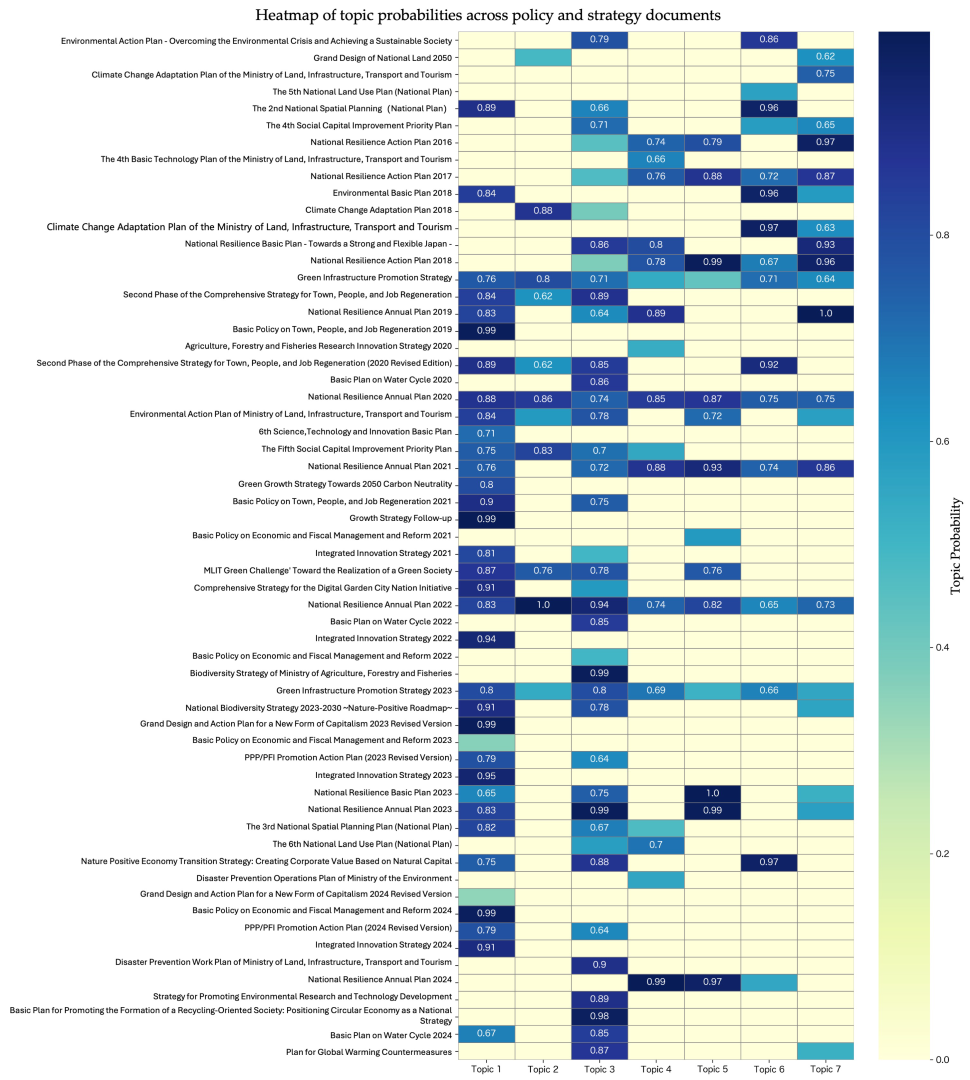
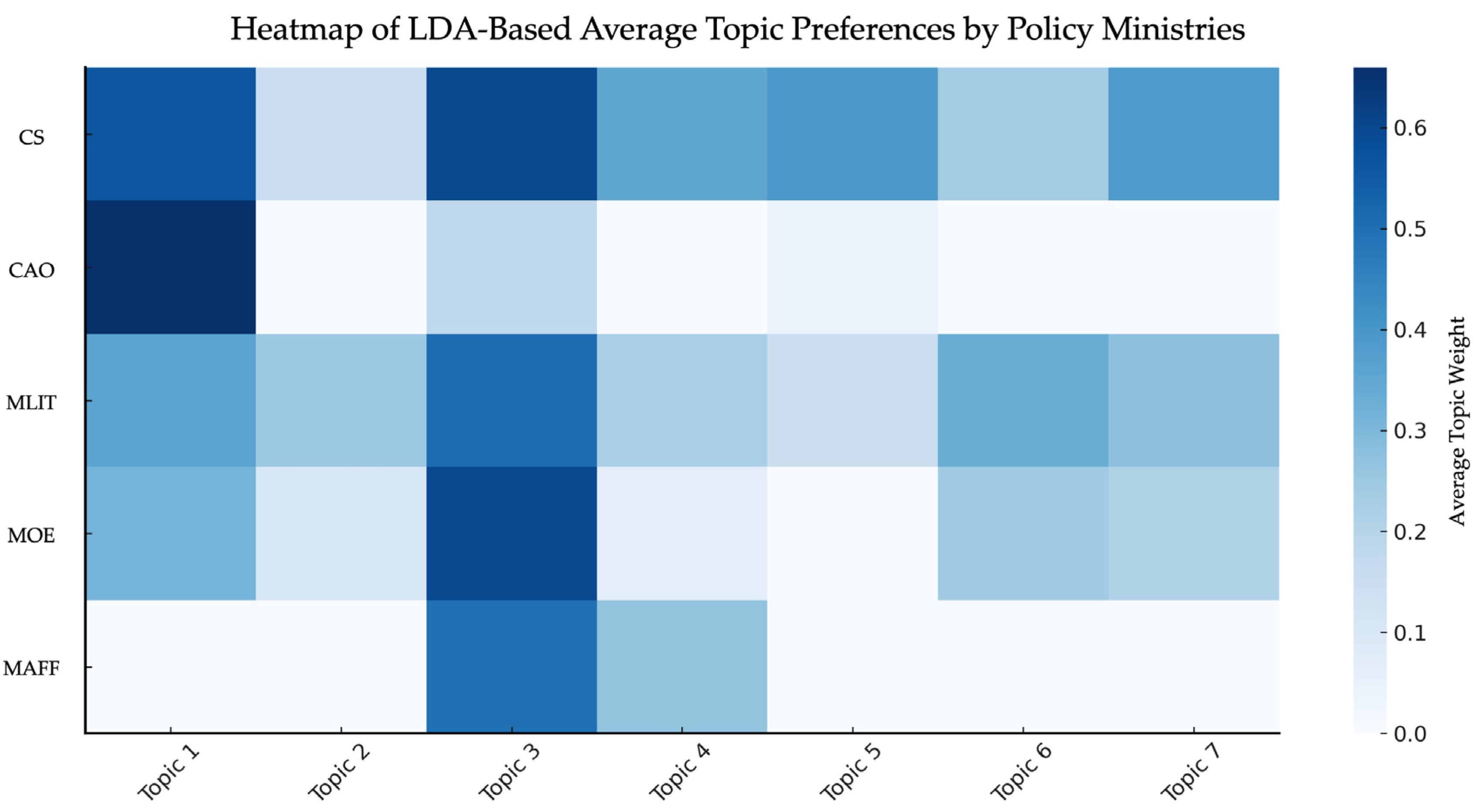
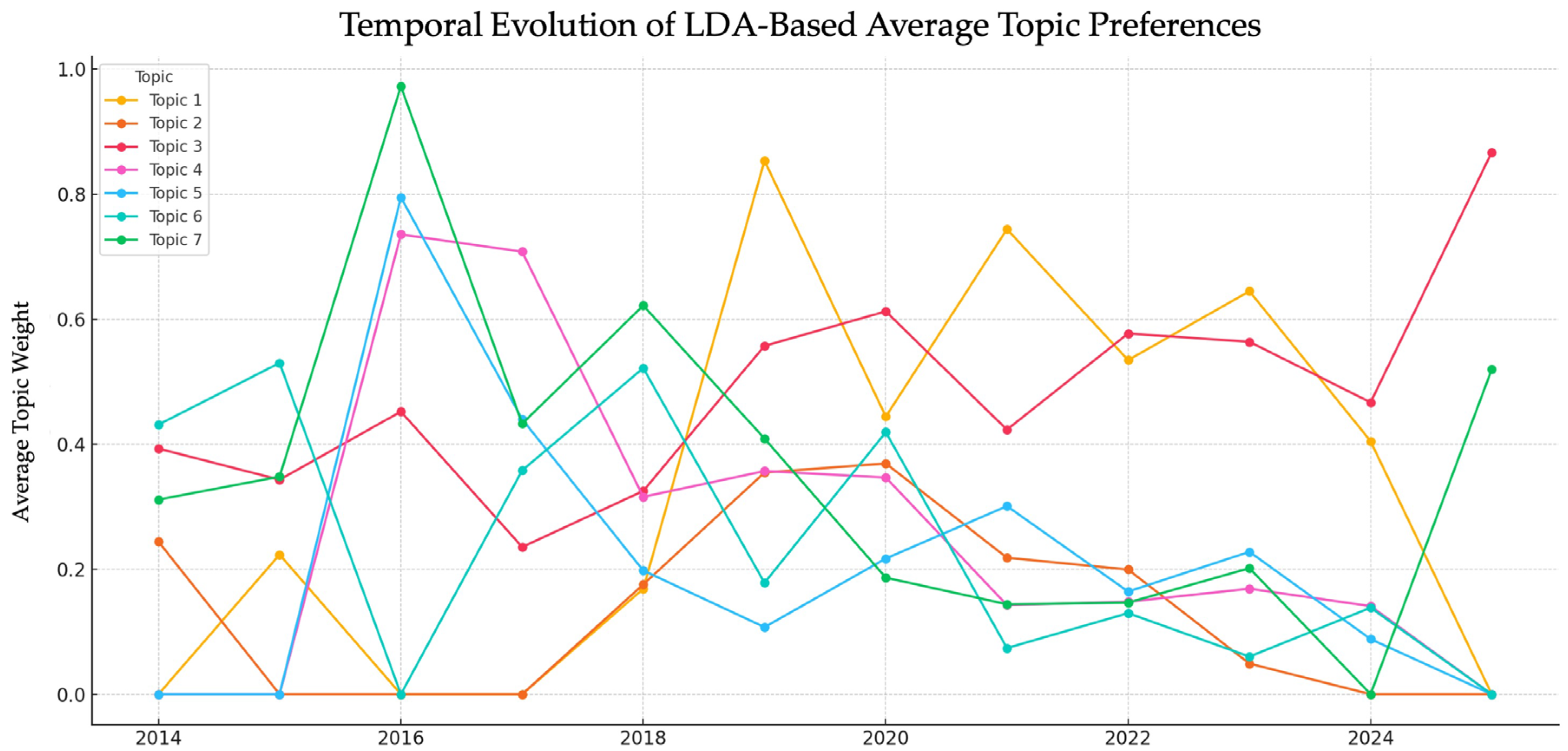
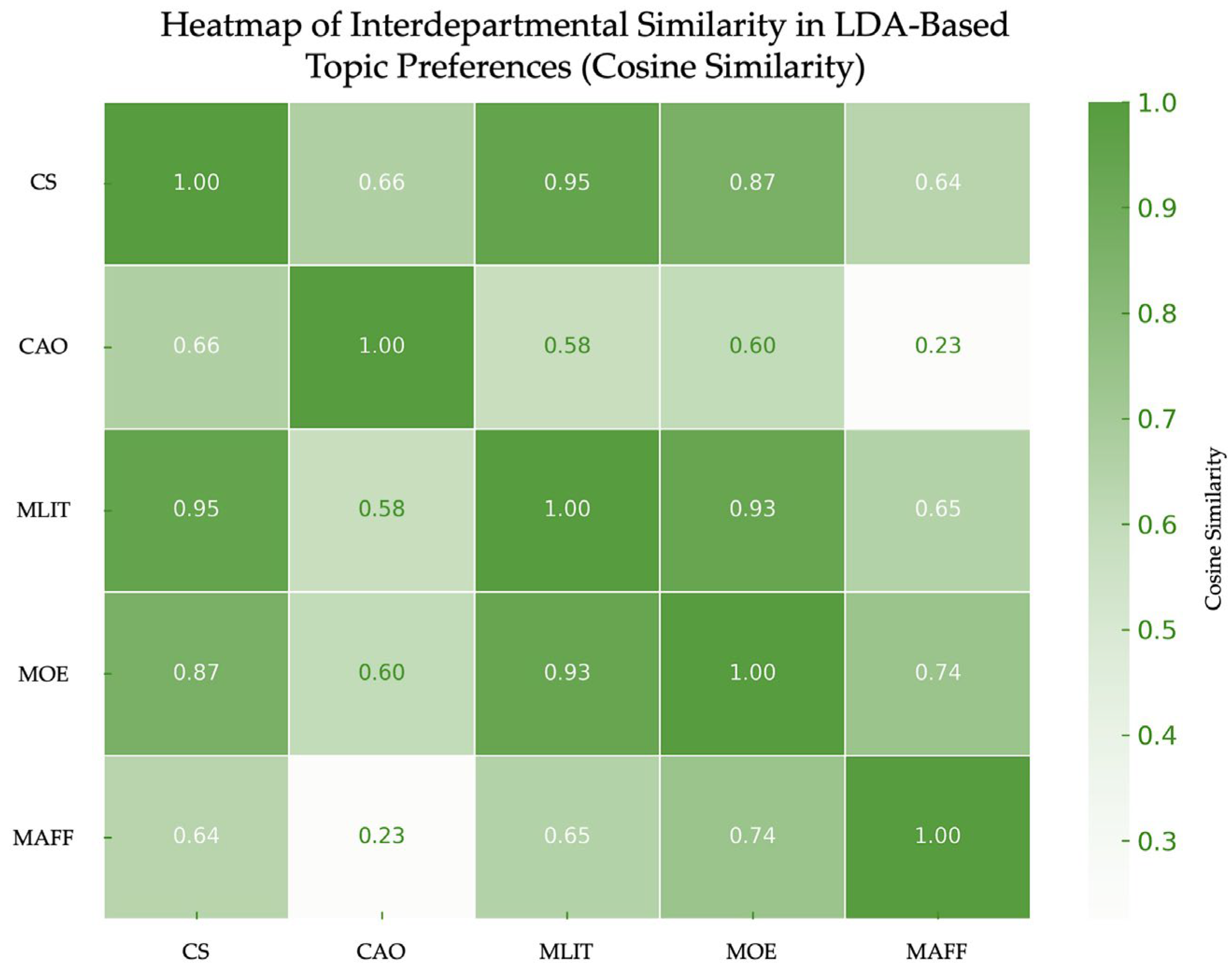
| Issuing Ministry | Date of Publication | Policy Title (English Translation) |
|---|---|---|
| Ministry of Land, Infrastructure, Transport and Tourism (MLIT) | 2014/3 | Environmental Action Plan—Overcoming the Environmental Crisis and Achieving a Sustainable Society |
| 2014/7 | Grand Design of National Land 2050 | |
| 2015/8 | The 2nd National Spatial Planning (National Plan) | |
| 2015/8 | The 5th National Land Use Plan (National Plan) | |
| 2015/9 | The 4th Social Capital Improvement Priority Plan | |
| 2015/11 | Climate Change Adaptation Plan of the Ministry of Land, Infrastructure, Transport and Tourism | |
| 2017/3 | The 4th Basic Technology Plan of the Ministry of Land, Infrastructure, Transport and Tourism | |
| 2018/11 | Climate Change Adaptation Plan of the Ministry of Land, Infrastructure, Transport and Tourism | |
| 2019/7 | Green Infrastructure Promotion Strategy | |
| 2021/5 | The Fifth Social Capital Improvement Priority Plan | |
| 2021/7 | MLIT Green Challenge Toward the Realization of a Green Society | |
| 2021/12 | Environmental Action Plan of the Ministry of Land, Infrastructure, Transport and Tourism | |
| 2022/4 | The 5th Basic Technology Plan of the Ministry of Land, Infrastructure, Transport and Tourism | |
| 2023/7 | The 3rd National Spatial Planning Plan (National Plan) | |
| 2023/7 | The 6th National Land Use Plan (National Plan) | |
| 2023/9 | Green Infrastructure Promotion Strategy 2023 | |
| 2024/6 | Disaster Prevention Work Plan of the Ministry of Land, Infrastructure, Transport and Tourism | |
| Ministry of the Environment (MOE) | 2015/11 | Climate Change Adaptation Plan |
| 2018/4 | Environmental Basic Plan 2018 | |
| 2018/11 | Climate Change Adaptation Plan 2018 | |
| 2023/3 | National Biodiversity Strategy 2023–2030 ~Nature-Positive Roadmap~ | |
| 2024/3 | Nature Positive Economy Transition Strategy: Creating Corporate Value Based on Natural Capital | |
| 2024/4 | Disaster Prevention Operations Plan of the Ministry of the Environment | |
| 2024/8 | Strategy for Promoting Environmental Research and Technology Development | |
| 2024/8 | Basic Plan for Promoting the Formation of a Recycling-Oriented Society: Positioning Circular Economy as a National Strategy | |
| 2025/2 | Plan for Global Warming Countermeasures | |
| Ministry of Agriculture, Forestry and Fisheries (MAFF) | 2016/5 | Basic Plan for Forest and Forestry |
| 2020/5 | Agriculture, Forestry and Fisheries Research Innovation Strategy 2020 | |
| 2023/3 | Biodiversity Strategy of Ministry of Agriculture, Forestry and Fisheries | |
| 2023/12 | Basic Plan for the Management and Administration of National Forests and Woodlands | |
| Cabinet Office (CAO) | 2021/3 | 6th Science, Technology and Innovation Basic Plan |
| 2021/6 | Basic Policy on Economic and Fiscal Management and Reform 2021 | |
| 2021/6 | Integrated Innovation Strategy 2021 | |
| 2022/6 | Basic Policy on Economic and Fiscal Management and Reform 2022 | |
| 2022/6 | Integrated Innovation Strategy 2022 | |
| 2023/6 | Basic Policy on Economic and Fiscal Management and Reform 2023 | |
| 2023/6 | Integrated Innovation Strategy 2023 | |
| 2023/6 | Grand Design and Action Plan for a New Form of Capitalism, 2023 Revised Version | |
| 2023/6 | PPP/PFI Promotion Action Plan (2023 Revised Version) | |
| 2024/6 | Basic Policy on Economic and Fiscal Management and Reform 2024 | |
| 2024/6 | Integrated Innovation Strategy 2024 | |
| 2024/6 | Grand Design and Action Plan for a New Form of Capitalism, 2024 Revised Version | |
| 2024/6 | PPP/PFI Promotion Action Plan (2024 Revised Version) | |
| Cabinet Secretariat (CS) | 2016/5 | National Resilience Action Plan 2016 |
| 2017/6 | National Resilience Action Plan 2017 | |
| 2018/6 | National Resilience Action Plan 2018 | |
| 2018/12 | National Resilience Basic Plan—Toward a Strong and Flexible Japan- | |
| 2019/6 | National Resilience Annual Plan 2019 | |
| 2019/6 | Basic Policy on Town, People, and Job Regeneration 2019 | |
| 2019/12 | Second Phase of the Comprehensive Strategy for Town, People, and Job Regeneration | |
| 2020/6 | National Resilience Annual Plan 2020 | |
| 2020/6 | Basic Plan on Water Cycle 2020 | |
| 2020/7 | Basic Policy on Town, People, and Job Regeneration 2020 | |
| 2020/12 | Second Phase of the Comprehensive Strategy for Town, People, and Job Regeneration (2020 Revised Edition) | |
| 2021/6 | Growth Strategy Follow-up | |
| 2021/6 | National Resilience Annual Plan 2021 | |
| 2021/6 | Basic Policy on Town, People, and Job Regeneration 2021 | |
| 2022/6 | National Resilience Annual Plan 2022 | |
| 2022/6 | Basic Plan on Water Cycle 2022 | |
| 2022/12 | Comprehensive Strategy for the Digital Garden City Nation Initiative | |
| 2023/7 | National Resilience Basic Plan 2023 | |
| 2023/7 | National Resilience Annual Plan 2023 | |
| 2023/12 | Comprehensive Strategy for the Digital Garden City Nation Initiative (2023 Revised Edition) | |
| 2024/7 | National Resilience Annual Plan 2024 | |
| 2024/8 | Basic Plan on Water Cycle 2024 | |
| Government of Japan (All Ministries) | 2021/6 | Green Growth Strategy Toward 2050 Carbon Neutrality |
| Visual Distribution | Thematic Cluster | Representative Keywords (Visual Cluster) | Interpreted Semantic Function/ Policy Implication |
|---|---|---|---|
| Semantic Core Clusters | Core Governance and Societal Structure | Green Infrastructure, Diversity, Public–Private, Platform, Actor, Local, Public, Implementation, Field | Highlights LGI as a central coordination mechanism and governance platform that enables cross-sectoral participation and multi-actor collaboration |
| Disaster Response and Risk Control | Disaster Prevention, Disaster Mitigation, Earthquake, Risk, Evacuation, Earthquake Resistance, Damage, Prevention | Emphasizes LGI’s role as a key tool in disaster risk reduction and urban resilience, with frequent co-occurrence of terms related to earthquake prevention and emergency response. | |
| Ecological Protection and Environmental Restoration | Nature, Conservation, Ecology, Forest, Coastline, Watercourse, Sustainability, Regeneration | Reflects strong associations between LGI and natural systems, ecological recovery, and long-term sustainability, forming a pathway for interpreting GI as ecological infrastructure. | |
| Spatial Utilization and Development Optimization | Urban, Territory, Management, Development, Improvement, Design, Enhancement, Appropriate | Suggests a technocratic framing of LGI in relation to urban and territorial development, emphasizing its functional value in improving spatial layouts and planning efficiency. | |
| Peripheral Scattered Clusters | Methodological and Policy Extension | Method, Model, Funding, Realization, Formulation, Strategy, Capital, Efficiency, Expansion | Indicates an emerging narrative of institutionalization, financialization, and systematization of LGI, possibly reflecting the policy push toward technical integration and implementation frameworks. |
| Cultural and Social-Semantic Margins | Culture, Attractiveness, Thinking, Community, Residents, Self-Governance | Focuses on a small group of culturally embedded and place-based terms, suggesting the potential for community-level engagement and the socio-cultural integration of LGI practices. |
| Topic Number | Representative Keywords (Ordered by Weight) | Topic Description |
|---|---|---|
| Topic 1 | Green Infrastructure, Implementation, Green, Development, Private Sector, Promotion, Introduction | Centered on “green infrastructure”, “implementation”, and “promotion”, this topic emphasizes institutional mechanisms that facilitate the introduction and application of LGI, particularly through public–private cooperation. |
| Topic 2 | Land Use, Space, Management, Shaping, Design, Urban Development, Urban | These keywords highlight the spatial integration of LGI in urban and territorial planning, especially in areas related to design, land development, and spatial governance. The documents focus on spatial planning tools and ecologically oriented development strategies. |
| Topic 3 | Flood Control, Watershed, Dam, Rainwater, Infiltration, Discharge, Water Cycle | This cluster emphasizes the hydrological and ecological regulation functions of LGI, with keywords focusing on water resource utilization and flood risk management. The texts reflect LGI’s application in basin-scale planning and urban water circulation through nature-based approaches. |
| Topic 4 | Disaster Prevention, Disaster Mitigation, Earthquake Resistance, Evacuation, Tsunami, Resilience, Disaster | The high-weighted terms reflect LGI’s role in disaster response, especially in earthquake, flood, and evacuation contexts. LGI is framed as a “green disaster prevention infrastructure”, contributing to resilient urban development. |
| Topic 5 | Nature, Ecosystem, Conservation, Forest, Regeneration, Coexistence, Diversity | This topic is focused on ecosystem protection and biodiversity. The high-weighted keywords convey a vision of an “ecological symbiosis society”, where LGI functions as a mechanism to support biodiversity restoration and ecosystem services. |
| Topic 6 | Public–Private, Collaboration, Community, Diversity, Citizens, Actor, Self-Governance | The cluster highlights structural features of multi-actor governance, with emphasis on local autonomy, public–private platforms, and community collaboration mechanisms that facilitate broad-based LGI implementation. |
| Topic 7 | Culture, Attractiveness, Local, Life, Tradition, Landscape, Tourism | These keywords reflect humanistic and cultural elements, indicating that LGI not only carries ecological and technical value but also serves to enhance local attractiveness and integrate historical, cultural, and scenic characteristics—representing a policy trend toward cultural embedding and soft governance. |
| Key Milestone | Year | Organization | Policy or Action |
|---|---|---|---|
| Starting Point | 2014 | Intergovernmental Panel on Climate Change (IPCC) | IPCC Fifth Assessment Report (AR5) |
| 2014 | European Commission | European Union (EU) Green Infrastructure Strategy (implementation phase) | |
| 2014 | United Nations International Strategy for Disaster Reduction (precursor to United Nations Office for Disaster Risk Reduction) | Preparation for the Sendai Framework for Disaster Risk Reduction | |
| Turning Point | 2020 | Multiple (United Nations Environment Programme, EU, national governments) | Global Green Recovery Policies post-COVID |
| 2022 | Convention on Biological Diversity (CBD) | Kunming–Montreal Global Biodiversity Framework (“30 × 30” Target) | |
| Critical Point | 2023 | United Nations Framework Convention on Climate Change (UNFCCC) 28th Conference of the Parties to the UNFCCC (COP28) | COP28 highlights: Nature-based Solutions and Adaptation |
| 2023 | United Nations | UN Water Conference—emphasis on urban water resilience and GI | |
| 2023 | Taskforce on Nature-related Financial Disclosures (TNFD)/global financial sector | Expansion of Environmental, Social, and Governance (ESG), Nature Capital Accounting, and TNFD disclosure frameworks |
Disclaimer/Publisher’s Note: The statements, opinions and data contained in all publications are solely those of the individual author(s) and contributor(s) and not of MDPI and/or the editor(s). MDPI and/or the editor(s) disclaim responsibility for any injury to people or property resulting from any ideas, methods, instructions or products referred to in the content. |
© 2025 by the authors. Licensee MDPI, Basel, Switzerland. This article is an open access article distributed under the terms and conditions of the Creative Commons Attribution (CC BY) license (https://creativecommons.org/licenses/by/4.0/).
Share and Cite
Yang, X.; Chen, Y.; Wang, Q.; Kinoshita, T. The Policy Positioning and Strategic Expectations of Landscape-Scale Green Infrastructure in Japan’s National-Level Policies. Land 2025, 14, 1160. https://doi.org/10.3390/land14061160
Yang X, Chen Y, Wang Q, Kinoshita T. The Policy Positioning and Strategic Expectations of Landscape-Scale Green Infrastructure in Japan’s National-Level Policies. Land. 2025; 14(6):1160. https://doi.org/10.3390/land14061160
Chicago/Turabian StyleYang, Xiaoqi, Yifan Chen, Qian Wang, and Takeshi Kinoshita. 2025. "The Policy Positioning and Strategic Expectations of Landscape-Scale Green Infrastructure in Japan’s National-Level Policies" Land 14, no. 6: 1160. https://doi.org/10.3390/land14061160
APA StyleYang, X., Chen, Y., Wang, Q., & Kinoshita, T. (2025). The Policy Positioning and Strategic Expectations of Landscape-Scale Green Infrastructure in Japan’s National-Level Policies. Land, 14(6), 1160. https://doi.org/10.3390/land14061160






